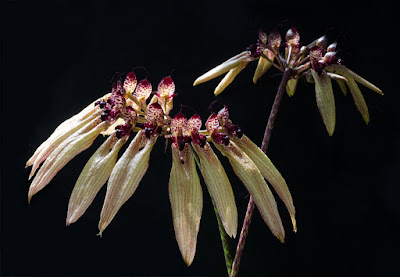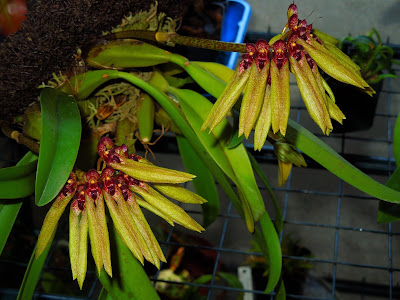Bulbophyllum picturatum is native to Northeast India, Myanmar, Thailand and Vietnam. In Thailand, this species grows at an altitude of 900-1000 m. In Vietnam it occurs at an altitude of 1000-1550 m.
Bulbophyllum picturatum, also called as The Striking Bulbophyllum, Cirrhopetalum picturatum, Phyllorchis picturata, is a species of the genus Bulbophyllum. This species was described by Heinrich Gustav Reichenbach in 1861.
IDENTIFY BULBOPHYLLUM PICTURATUM
Bulbophyllum picturatum is native to Northeast India, Myanmar, Thailand and Vietnam. In India this orchid was found in Lushai Hills. This species also are found in Myanmar near Moulmein. In Thailand, they were found near Mae Sarieng at an altitude of 900-1000 m. In Vietnam, they were encountered near Prenn, Dalat and a few other places on the Langbian Plateau, at an altitude of 1000-1550 m.
It is a small sized, warm to cool growing epiphyte with ovoid, angular, dark green, 5.0-7.5 cm long pseudobulbs carrying a single, apical, linear-oblong, obtuse, 7.5-12.5 cm long and 1.7-2.2 cm wide leaf. The leaf is straight, has a rounded apex, and tapers at the base to form a short petiole.
The Striking Bulbophyllum blooms in the spring on a basal, ascending, 5 to 10" (12 to 25 cm) long, slender, bracteate inflorescence that arises from an older pseudobulb and has 5 to 10 umbellate, fragrant, hirsute flowers. The flower is about 5 cm long. The dorsal petal is straight, blunt ended, matte-green with red spots and has purple, twisted, filamentous appendages at the apex. The side petals are matt, light green, oblong-lanceolate, with edges connected to each other almost along the entire length.. The inner coat flakes are matte-green with red spots, ovate, with denticulate tops and filiform outgrowths on them. The lip is blood-red, in the shape of a tongue, it is curved downwards by more than 90 °, it is bluntly terminated and at the base has a few straight ears in the shape of the ears.
BULBOPHYLLUM PICTURATUM CARE AND CULTURE
Cultural information should only be used as a guide, and should be to be adapted to suit you. Your physical location; where you grow your plants, how much time you have to devote to their care, and many other factors, will need to be taken into account. Only then can you decide on the cultural methods that best suit you and your plants.
Light:
Bulbophyllum picturatum needs a light level of 12000-23000 lux. The light should be filtered or dispersed, and the plants should not be exposed to the direct sunlight of the midday sun. Strong air movement should be ensured all the time.
Temperature:
The average temperature of summer days is 27-28 ° C, nights 19-20 ° C, and the daily difference is 7-8 ° C. The average temperature of spring days is 31-33 ° C, night 14-21 ° C, and the daily difference is 18-10 ° C. The average temperature of winter days is 26-29 ° C, night 10-12 ° C, and the daily difference is 14-19 ° C.
Humidity:
This species needs a humidity level of 80-85% in the summer and early autumn and falls slowly to 55-60% for a period of 2-3 months at the end of winter and early spring.
Substrate, growing media:
Bulbophyllum picturatum grows best and are easiest to manipulate when mounted on pieces of branches with uneven bark or on tree fern rootstock, however, it require high humidity and in hot and dry weather they may require even several waterings during the day.
The Striking Bulbophyllum can also grow in very shallow pots or baskets, using a very loose, quickly drying ground. For fine or medium-sized bark or chopped tree fern fibers, moisture-retaining additives such as perlite or chopped sphagnum moss are used. It is preferred to use tree fern fibers, because it does not decompose as quickly as the bark, which means that repotting does not have to be too frequent, which should be taken into account.
Repotting:
Bulbophyllum picturatum do not grow well after moving their root ball, plants often get sick up to a year or more after dividing or repotting. If the substrate is not laid down and the plant has grown out of the container, it must be removed from the smaller container together with the substrate and put into a larger basket or pot without disturbing the roots. When a plant needs to be repotted, it is best to do it when new roots start growing, which will help the plant stabilize as quickly as possible. If the substrate begins to decompose, the plant should be immediately repotted.
Watering:
Bulbophyllum picturatum should often be watered during active growth from late spring until autumn, but their roots must dry quickly after watering. The substrate around the roots can never be soggy or damp. When new growths reach maturity in autumn, the amount of water should be gradually reduced.
Fertilizer:
It is recommended to feed weekly fertilizer 1/4-1/2 fertilizer doses for orchids. You can apply a balanced fertilizer all year round, and you can use a fertilizer with a high nitrogen content from spring to mid summer, and then until the end of autumn - a fertilizer with a high content of phosphorus.
Rest period:
In the winter, water should be reduced in quantity so that Bulbophyllum picturatum can dry out between watering, but they can not remain completely without water for too long. During this period, enough moisture will provide fairly regular morning fogging between light, occasional watering. For about 1 month at the end of winter or at the beginning of spring, however, the amount of water should be reduced to occasional morning nebulas and very rare, light watering. If the leaves began to wrinkle, or if the plant showed other disturbing signs, the amount of water can be increased. Fertilization should be reduced or eliminated whenever plants are not showing active growth. Plants are not able to collect fertilizers in the cold, so the level of salt in the substrate can reach a dangerous level when using fertilizer at low temperatures.















COMMENTS